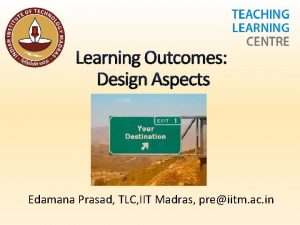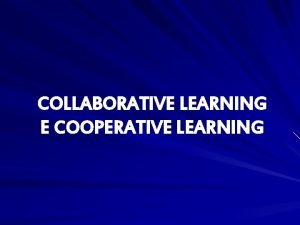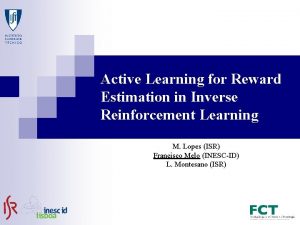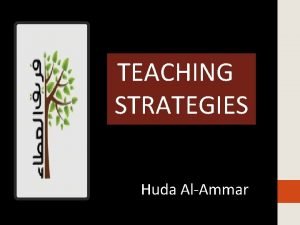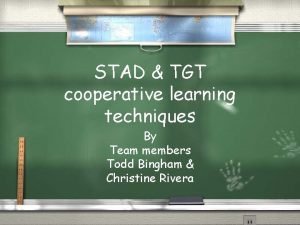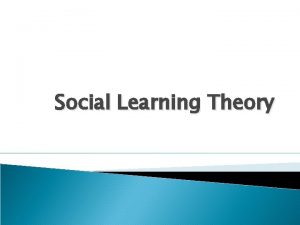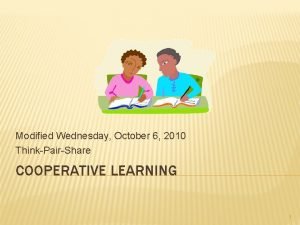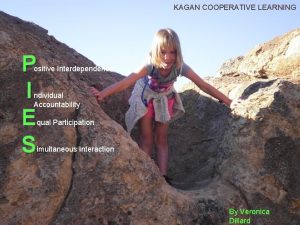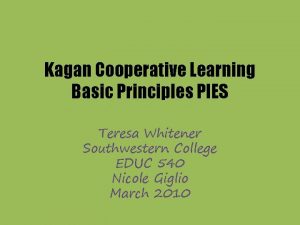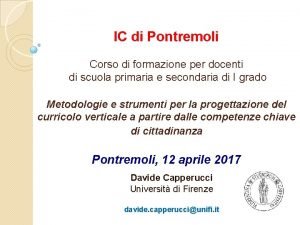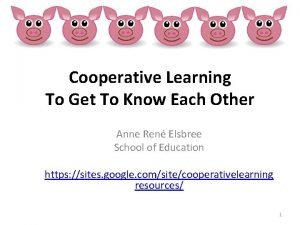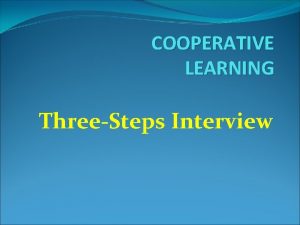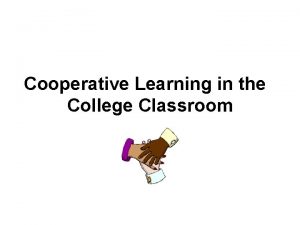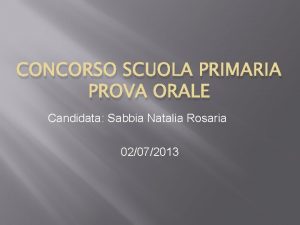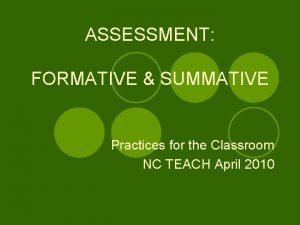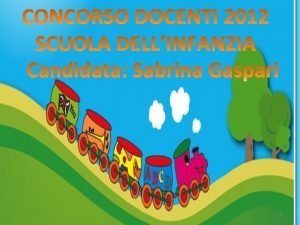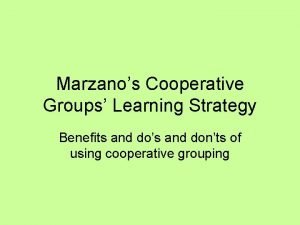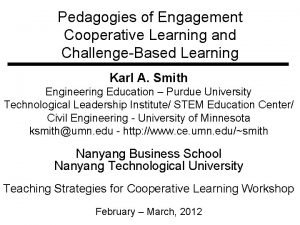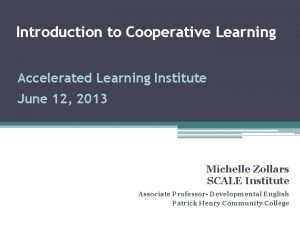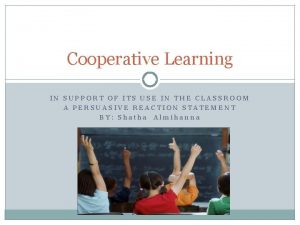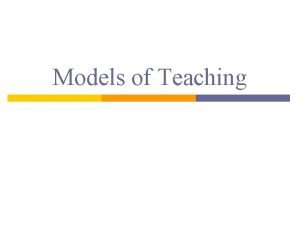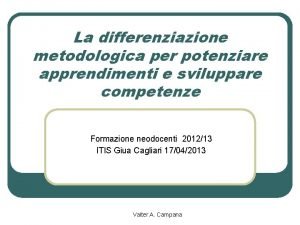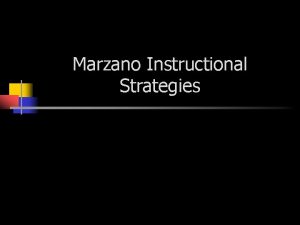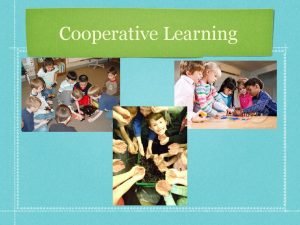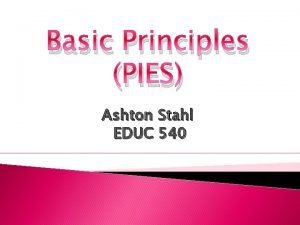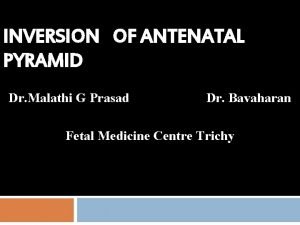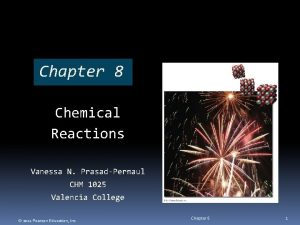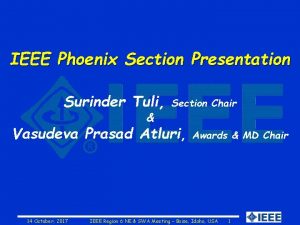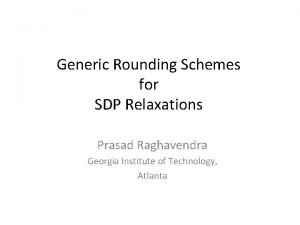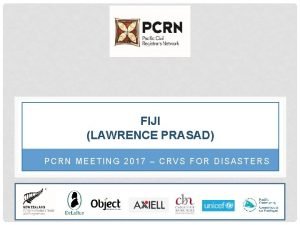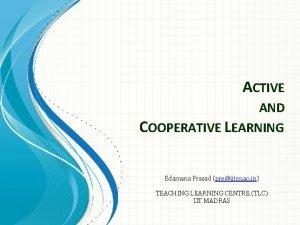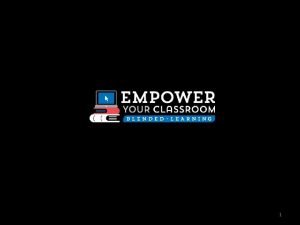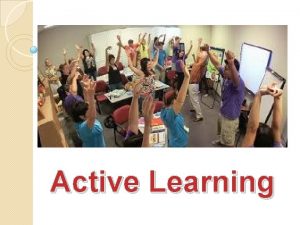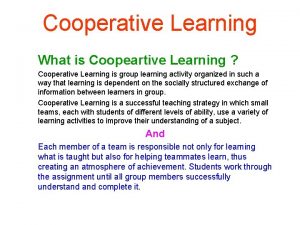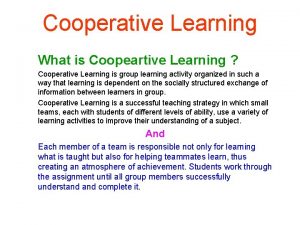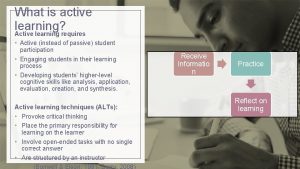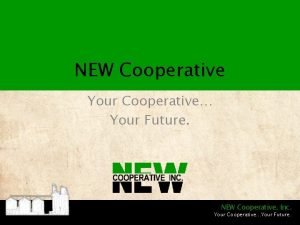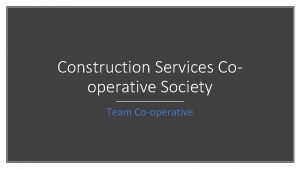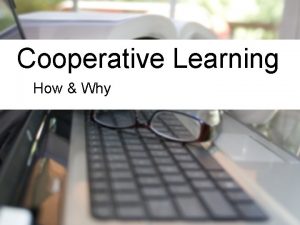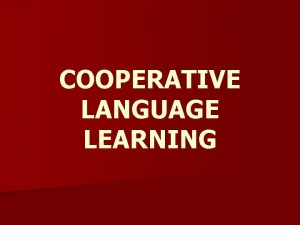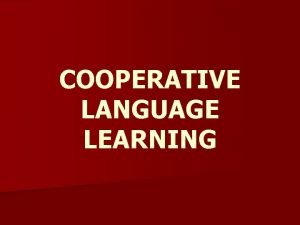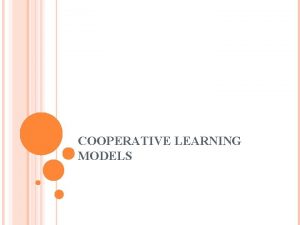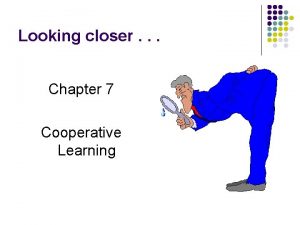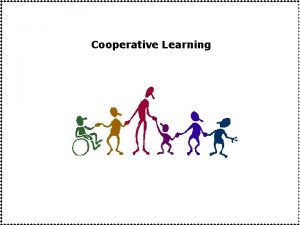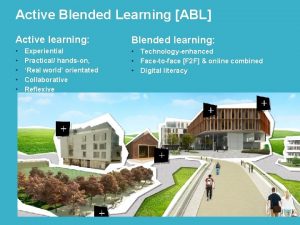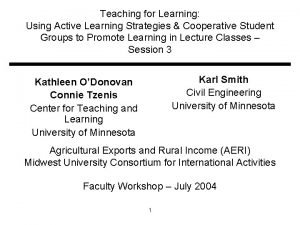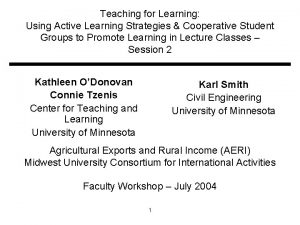ACTIVE AND COOPERATIVE LEARNING Edamana Prasad preiitm ac










































- Slides: 42

ACTIVE AND COOPERATIVE LEARNING Edamana Prasad (pre@iitm. ac. in) TEACHING LEARNING CENTRE (TLC) IIT MADRAS

Learning Outcome The participants should be able to: • Explain features of Active & Co-operative Learning (ACL) • Design an ACL activity in your class room

Course Delivery Cycle What changes will be incorporated in the next course offering? Reflection/ Documentation Course Portfolio Prior Knowledge? What will the students Coursebe able to do and. Outcomes Learning how will the students think when they What your student will be able complete my as a result of your instruction? course? Are the students meeting the learning outcomes/succeeding? What is working/not working in my course? Use Think/Pair/Share Do Demonstration Write Reflections Conduct Lectures Model thinking to do What evidence will the students and instructors have of success? How will I conduct class to assist students in their learning/success? Courtesy: Jeff Froyd Your Expectations • • • Homework Exams Portfolios Presentations Written reports Course survey data

Research Based Instructional Strategies (RBIS) • • • • Active learning Cooperative learning Informal cooperative learning Formal cooperative learning Collaborative learning Peer instruction Just-in-time teaching Problem based learning Cooperative problem based learning Project based learning Inquiry based learning Challenge based learning Process Oriented Guided Inquiry Learning (POGIL) Team based learning Studio physics Jigsaw • • • • Case base learning Service learning Project based service learning Think – pair – share Informal cooperative learning Think-aloud paired problem solving Discovery learning Structured controversy Concep. Tests Question driven learning Peer Led Team Learning (PLTL) Tutorials in Introductory Physics (Ti. IP) Small group learning Workshop physics Formative assessment Model eliciting activities

Book Ends on a Class Session Source: Karl Smith, University of Minnesota

Template: Bookend Lecture • Advance Organizer: Engage students immediately. Preview lecture – Example: Reading Quiz – Example: Application of Lecture Content – Example: Provocative Question – Example: …

Participant Task • Select a lecture you gave in a course recently. • Redesign the lecture using the bookend lecture template: • What is your advance organizer? • What is your summary activity? • What are your interactive activities? • 10 minutes

Addressing Student Resistance • Resistance to externally-induced change is inevitable. Anticipate and prepare. • Acknowledge changes and accompanying anxiety • Emphasize benefits and fun. Lots on research on benefits of student engagement and active/cooperative learning. • Plan to solicit feedback and respond constructively • Encourage students to visit with you about their doubts • Plan to talk one-on-one to most visibly anxious students Felder, R. M. and R. Brent (1996). "Navigating the Bumpy Road to Student–Centered Instruction. " College Teaching 44(2): 43– 47. Felder, R. M. and R. Brent (1994). Cooperative learning in technical courses: Procedures, pitfalls, and payoffs, ERIC Document Reproduction Service Report ED 377038. Washington, DC. Cooper, J. L. , J. Mac. Gregor, et al. (2000). "Implementing Small-Group Instruction: Insights from Successful Practitioners. " New Directions in Teaching and Learning 81: 64 -76.

Why Active/Cooperative Learning? • Wright, J. C. , Millar, S. B. , Kosciuk, S. A. , Penberthy, D. L. , Williams, P. H. , Wampold, B. E. (1998). A Novel Strategy for Assessing the Effects of Curriculum Reform on Student Competence. Journal of Chemical Education, 85(8), 986 -992 – Study shows a very thorough assessment of differences between a well-taught lecture class and a structured active learning class through the eyes of faculty who teach subsequent courses

Jigsaw • Break material to be covered into 4 -5 different topics • Create groups of students assigned to each topic. Each group will work so its members become experts on the assigned topic. • Create new groups of 4 -5 which contain one member from each expert group. New groups teach other about the 4 -5 topic.

Jigsaw: How it works Stage 1 Stage 2 Expert Group 1 Learning Group 1 Expert Group 2 Learning Group 2 Expert Group 3 Expert Group 4 Learning Group 3 Learning Group 4

Jigsaw: How it works • Stage 1 – Each expert group learns an assigned segment and prepares to teach it to the others • Stage 2 – Each learning group has xx experts who teach their segments to the group

Why Active/Cooperative Learning?

ACTIVE & COOPERATIVE LEARNING

ACL ü Positive Interdependence ü Individual Accountability Ø Group Processing Ø Social Skills ü Face-To-Face, Promotive Interaction

ACL Elements • Positive Interdependence - Team members must rely on each other to accomplish goals.

Activity – Positive Interdependence • THINK – PAIR – SHARE • How might you promote positive interdependence? • ?

Ideas – Positive Interdependence • Task Interdependence – Give a team a common task • Role Interdependence – Assign team members different roles and rotate • Reward Interdependence – Offer bonus points if every member achieves a set requirement • Resource Interdependence – Limit resources and develop complementary expertise

ACL Elements • Individual Accountability Members are held accountable for doing their share of the work, as well as mastering all material.

Activity – Individual Accountability • THINK – PAIR – SHARE • How might you promote individual accountability? • ?

Ideas – Individual Accountability Individual exams Ask one member to explain results/learning Small groups, cuts down slackers Ask members to apply group learning to individual task, e. g. , individual report memos • Everyone signs: “I participated, I agree, and I can explain the information” • Random checking • •

Various Active Learning Strategies • bookend model • Jigsaw • ? ?

Various Active Learning Strategies • • • Group Discussions Concept Mapping Scaffolding Flipped Class POGIL Problem Based Learning

ACL Elements • Face-to-Face Interaction Some or all work should be done by members working together.

Activity – Face-to-Face Interaction • THINK – PAIR – SHARE • How might you promote face-to-face interactions? • ?

Ideas – Face-to-Face Interaction • Avoid assignments that can be parceled out, e. g. , long papers, extended programming assignments • Ask team to generate multiple good ideas and you pick one for further work • Ask multiple choice questions and require one answer from team • Form heterogeneous groups to promote diverse perspectives

ACL Elements • Group Processing Teams periodically reflect on what they do well as a team, what they could improve, and what they might need to do differently.

Activity – Group Processing • THINK – PAIR – SHARE • How might you promote group processing? • ?

Ideas – Group Processing • Complete plus-delta at end of team assignment • Ask for reflections on team process during an extended project – What is working? What are challenges to be addressed? • Ask: How is team meeting Code of Cooperation

ACL Elements • Social Skills - Team members practice and receive instruction in listening, meetings, leadership, decisionmaking, conflict management, and communication.

Ideas – Social Skills • • • Brief Activities – Listening Brief Activities – Conflict Brief Activities – Communication Provide guidance on effective meetings Exercises on reaching decisions

Questions about Teams • How do I form teams? • How do I facilitate dysfunctional teams? • How do I assess individual performance for team projects? • How do I monitor progress of team projects? • How might I help students with – Conflict? – Communication? – Decision making?

Activity – Forming Teams • THINK – PAIR – SHARE • Individually: What suggestions would you offer forming teams? • Pair: Turn to a neighbor and exchange ideas. • Share: – ? ?

Forming Teams • Instructor assigns teams • Size: 3 -5 (I like 4) • Heterogeneity – Grades – Backgrounds – Learning styles • Carefully consider how possibly marginalized students are assigned • Get input from students: geography, schedules …

Activity – Starting Teams • THINK – PAIR – SHARE • Individually: What suggestions would you offer for getting teams off to a good start? • Pair: Turn to a neighbor and exchange ideas. • Share: – – – – – Introduce each other, what do you like Pick a representative Each team defines individual responsibilities and collective goals Come up with a work plan Pick a meeting place and time Let uncomfortableness be known Rules made clear Get team codes of cooperative Agree to disagree

Starting Teams • Get acquainted – Taking time to learn about your teammates is a good investment. • Motivate groups to build teams – Why teams? • Establish a set of group goals – Generate teams goals for project • Construct a code of cooperation – Team agreement on expectations • Organize – Conducting productive meetings – Roles • Potential problem members – Ask teams to identify potential problems and develop strategies

• • • Springer, L. , Stanne, M. E. , and Donovan, S. S. (1999). Effects of small-group learning on undergraduates in science, mathematics, engineering, and technology: A meta-analysis. Review of Educational Research, 69(1), 21– 51 Wage, K. E. , Buck, J. R. , Wright, C. H. G. , and Welch, T. B. (2005). The Signals and Systems Concept Inventory. IEEE Transactions on Education, 48(3), 448– 461 Buck, J. R. , and Wage, K. E. (2005). Active and Cooperative Learning in Signal Processing Courses. IEEE Signal Processing Magazine, 22(2), 76– 81 Crouch, C. H. , and Mazur, E. (2001). Peer Instruction: Ten years of experience and results. American Journal of Physics, 69(9), 970– 977 Wright, J. C. , Millar, S. B. , Kosciuk, S. A. , Penberthy, D. L. , Williams, P. H. , and Wampold, B. E. (1998). A Novel Strategy for Assessing the Effects of Curriculum Reform on Student Competence. Journal of Chemical Education, 85(8), 986– 992 Prince, M. (2004). Does Active Learning Work? A Review of the Research. Journal of Engineering Education, 93(3), 223– 231 Johnson, D. W. , Johnson, R. T. , and Smith, K. A. (1998). Cooperative Learning Returns to College: What Evidence Is There That It Works? Change, 30(4), 26– 35 Bowen, C. W. (2000). A Quantitative Literature Review of Cooperative Learning Effects on High School and College Chemistry Achievement. Journal of Chemical Education, 77(1), 116– 119 Felder, R. M. , Felder, G. N. , and Dietz, E. J. (1998). A Longitudinal Study of Engineering Student Performance and Retention. V. Comparisons with Traditionally-Taught Students. Journal of Engineering Education, 98(4), 469– 480 Terenzini, P. T. , Cabrera, A. F. , Colbeck, C. L. , Parente, J. M. , and Bjorklund, S. A. (2001). Collaborative Learning vs. Lecture/Discussion: Students' Reported Learning Gains. Journal of Engineering Education, 90(1), 123– 130 Bonsangue, M. (1994). An efficacy study of the calculus workshop model. CBMS Issues in Collegiate Mathematics Education, 4, Providence, RI: American Mathematical Society, 117– 137 Beichner, R. J. , Saul, J. M. , Abbott, D. S. , Morse, J. J. , Deardorff, D. L. , Allain, R. J. , Bonham, J. W. , Dancy, M. H. , and Risley, J. S. (2007). The Student-Centered Activities for Large Enrollment Undergraduate Programs (SCALE-UP) Project. Retrieved August 27, 2007, from http: //www. compadre. org/Repository/document/Serve. File. cfm? ID=4517&Doc. ID=183

QUESTIONS?




Minute Paper • What was the most useful or meaningful thing you learned during the session? • What was the “muddiest” point in this session?
 Edamana prasad
Edamana prasad Collaborative learning vs cooperative learning
Collaborative learning vs cooperative learning Passive learning vs active learning
Passive learning vs active learning Active learning reinforcement learning
Active learning reinforcement learning Cooperative vs collaborative learning
Cooperative vs collaborative learning Tgt cooperative learning
Tgt cooperative learning Social definition
Social definition Pedagogia non direttiva rogers
Pedagogia non direttiva rogers Think pair share cooperative learning
Think pair share cooperative learning Pies kagan
Pies kagan Kagan pies
Kagan pies Compito di realtà esempi
Compito di realtà esempi Pigs face cooperative learning
Pigs face cooperative learning 3 step interview
3 step interview Example of cooperative learning
Example of cooperative learning Griglia di osservazione cooperative learning
Griglia di osservazione cooperative learning Evaluation continuum
Evaluation continuum Griglia di osservazione cooperative learning
Griglia di osservazione cooperative learning Marzano cooperative learning
Marzano cooperative learning Formal cooperative learning
Formal cooperative learning Cooperative learning institute
Cooperative learning institute Types of cooperative learning
Types of cooperative learning Types of learning model
Types of learning model Purpose of teaching method
Purpose of teaching method Classificazione delle metodologie didattiche
Classificazione delle metodologie didattiche Marzano instructional strategies
Marzano instructional strategies Formal cooperative learning
Formal cooperative learning Cooperative learning round robin
Cooperative learning round robin Pies prensiles
Pies prensiles 3 to 8 decoder truth table
3 to 8 decoder truth table Primary vs secondary active transport
Primary vs secondary active transport Pochampalli fill in the blanks
Pochampalli fill in the blanks Cuadro comparativo e-learning m-learning b-learning
Cuadro comparativo e-learning m-learning b-learning Primary active transport vs secondary active transport
Primary active transport vs secondary active transport Dr annie prasad
Dr annie prasad Sudhakar prasad
Sudhakar prasad Srinivas kantipudi
Srinivas kantipudi Dr prasad gourineni
Dr prasad gourineni Drbavaharan13
Drbavaharan13 Combination reaction example
Combination reaction example Vasudeva prasad atluri
Vasudeva prasad atluri Prasad raghavendra
Prasad raghavendra Lawrence prasad
Lawrence prasad
